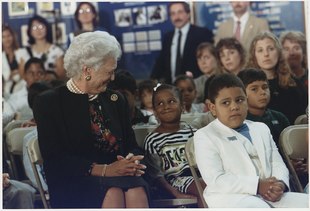
Literacy in the United States was categorized by the National Center for Education Statistics into different literacy levels, with 92% of American adults having at least "Level 1" literacy in 2014.[1] Nationally, over 20% of adult Americans have a literacy proficiency at or below Level 1. Adults in this range have difficulty using or understanding print materials. Those on the higher end of this category can perform simple tasks based on the information they read, but adults below Level 1 may only understand very basic vocabulary or be functionally illiterate. According to a 2020 report by Gallup based on data from the U.S. Department of Education, 54% of adults in the United States lack English literacy proficiency.[2]
In many nations, the ability to read a simple sentence suffices as literacy, and was the previous standard for the U.S. The definition of literacy has changed greatly; the term is presently defined as the ability to use printed and written information to function in society, to achieve one's goals, and to develop one's knowledge and potential.[3]
The United States Department of Education assesses literacy in the general population through its National Assessment of Adult Literacy (NAAL).[4] The NAAL survey defines three types of literacy:[5]
- Prose: the knowledge and skills needed to search, comprehend, and use continuous texts. Examples include editorials, news stories, brochures, and instructional materials.
- Document: the knowledge and skills needed to search, comprehend, and use non-continuous texts in various formats. Examples include job applications, payroll forms, transportation schedules, maps, tables, and drug and food labels.
- Quantitative: the knowledge and skills required to identify and perform computations, either alone or sequentially, using numbers embedded in printed materials. Examples include balancing a checkbook, figuring out tips, completing an order form, or determining an amount.
Modern jobs often demand a high literacy level, and its lack in adults and adolescents has been studied extensively.
According to a 1992 survey, about 40 million adults had Level 1 literary competency, the lowest level, comprising understanding only basic written instructions.[6] A number of reports and studies are published annually to monitor the nation's status, and initiatives to improve literacy rates are funded by government and external sources.[7]
- ^ "Report on Adult Literacy in the United States" (PDF). nces.ed.gov. United States Department of Education. July 2019. Retrieved October 16, 2021.
- ^ Gallup. "Low Literacy Levels Among U.S. Adults Could Be Costing The Economy $2.2 Trillion A Year" (PDF).[citation needed]
- ^ "Framework -> Definition of Literacy". National Assessment of Adult Literacy. National Center for Education Statistics. Retrieved 25 September 2019.
- ^ "National Assessment of Adult Literacy (NAAL)". National Center for Education Statistics. Archived from the original on September 22, 2019.
- ^ Cite error: The named reference
NCESLiteracyTypes2003was invoked but never defined (see the help page). - ^ Cite error: The named reference
NCES_1993was invoked but never defined (see the help page). - ^ Cite error: The named reference
Goldin1999was invoked but never defined (see the help page).
© MMXXIII Rich X Search. We shall prevail. All rights reserved. Rich X Search
